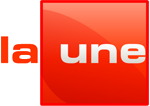La Une
| La Une | |
|---|---|
 |
|
| Launched | 31 October 1953 |
| Owned by | RTBF |
| Slogan | Regardez, ça vous regarde (Look, this concerns you) |
| Country | Belgium |
| Formerly called | INR (1953–1960) RTB (1960–1977) RTBF1 (1977–1997) RTBF La Une (1997–2004) |
| Sister channel(s) | La Deux, La Trois |
| Website | Official site of La Une |
|
Availability
|
|
| Terrestrial | |
| RTBF DVB-T (FTA) | Channel 1 |
| Satellite | |
| TéléSAT | Channel 1 |
| TV Vlaanderen | 60 |
| Cable | |
| Telenet Digital TV (Flanders) | Channel 130 (HD) Channel 790 |
| Telenet Digital TV (Brussels) | Channel 1 (HD) Channel 65 |
| Telenet | Refer to local listings at zenders.be |
| VOO Digital | Channel 501 (HD) Channel 1 |
| IPTV | |
| Belgacom TV (VDSL) (Wallonia) | Channel 1 Channel 40 (HD) |
| Belgacom TV (VDSL) (Brussels) | Channel 1 Channel 40 (HD) |
| Belgacom TV (VDSL) (Flanders) | Channel 40 (HD) Channel 220 |
La Une [la yn] is a Belgian national television channel, owned and operated by the French-language public-service broadcasting organization RTBF. La Une is considered the equivalent of Flemish station Eén, the first channel of the Flemish broadcaster, VRT.
Experimental television was born in Belgium June 2, 1953 with the live broadcast of the coronation of Queen Elizabeth II of the United Kingdom.
On 31 October at 20:30 from Studio 5 in Flagey, the headquarters of the National Institute of Belgian Radio (INR), Andrée Rolin officially opened the channel. After that, the announcer Janine Lambotte opens the broadcast with the new experimental television just born and broadcast 2 hours a day, 6 days a week. Transmission began with the French television news relayed by the RTF transmitter TV-Lille (France's first regional station), followed by the broadcast of the cabaret type and called Boum.
In the early days, the INR broadcast two to three evenings per week, with a strong focus on theatre and drama, and is released on Friday and during the holidays. On Wednesday and Sunday evenings, the channel broadcast its own productions. The rest of the programming was provided by RTF. The first live sports coverage began with the FIFA World Cup 1954 and Monday sports from 1955. The first newscast premièred on September 1, 1956, produced entirely in Brussels and with almost no pictures, except of the presenter reading the script.
The weather report already exists. For several years, it is in the form of animated cartoons corresponding to the time announced. These drawings are executed at the Royal Meteorological Institute Live from the frosted glass leaving only to see the drawing, a character with an umbrella or a radiant sun on bathers, etc. ... done by Bob Boudard, a whimsical cabaret with a talented cartoonist (and also capable of whistling and interpret various musical pieces). Hidden behind the frosted screen, Boudard must interpret the bulletin theft when he arrived at the institute, often at the last minute by taxi drivers who have learned to know and who are ready to go to bring in time because it has various obligations that occupy Brussels, among others hold its street cafe "Dominicans", visit many actors from the theaters of Brussels city centre.
...
Wikipedia
